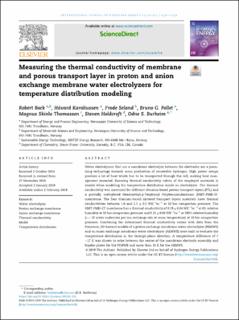| dc.contributor.author | Bock, Robert | |
| dc.contributor.author | Karoliussen, Håvard | |
| dc.contributor.author | Seland, Frode | |
| dc.contributor.author | Pollet, Bruno | |
| dc.contributor.author | Thomassen, Magnus | |
| dc.contributor.author | Holdcroft, Steven | |
| dc.contributor.author | Burheim, Odne Stokke | |
| dc.date.accessioned | 2020-11-26T10:44:37Z | |
| dc.date.available | 2020-11-26T10:44:37Z | |
| dc.date.created | 2019-02-17T17:26:51Z | |
| dc.date.issued | 2019 | |
| dc.identifier.citation | International journal of hydrogen energy. 2019, 45 (2), 1236-1254. | en_US |
| dc.identifier.issn | 0360-3199 | |
| dc.identifier.uri | https://hdl.handle.net/11250/2689736 | |
| dc.description.abstract | Water electrolyzers that use a membrane electrolyte between the electrodes are a promising technology towards mass production of renewable hydrogen. High power setups produce a lot of heat which has to be transported through the cell, making heat management essential. Knowing thermal conductivity values of the employed materials is crucial when modeling the temperature distribution inside an electrolyzer. The thermal conductivity was measured for different titanium-based porous transport layers (PTL) and a partially methylated Hexamethyl-p-Terphenyl Polybenzimidazolium (HMT-PMBI-Cl- membrane. The four titanium-based sintered transport layers materials have thermal conductivities between 1.0 and 2.5 0.2 WK−1m−1 at 10 bar compaction pressure. The HMT-PMBI-Cl- membrane has a thermal conductivity of 0.19 0.04 WK−1m−1 at 0% relative humidity at 10 bar compaction pressure and 0.21 0.03 WK−1m−1 at 100% relative humidity ( water molecules per ion exchange site at room temperature) at 10 bar compaction pressure. Combining the determined thermal conductivity values with data from the literature, 2D thermal models of a proton exchange membrane water electrolyzer (PEMWE) and an anion exchange membrane water electrolyzer (AEMWE) were built to evaluate the temperature distribution in the through-plane direction. A temperature difference of 7–17 K was shown to arise between the center of the membrane electrode assembly and bipolar plates for the PEMWE and more than 18 K for the AEMWE. | en_US |
| dc.language.iso | eng | en_US |
| dc.publisher | Elsevier | en_US |
| dc.rights | Navngivelse 4.0 Internasjonal | * |
| dc.rights.uri | http://creativecommons.org/licenses/by/4.0/deed.no | * |
| dc.subject | Temperature distribution | en_US |
| dc.subject | Model | en_US |
| dc.subject | Thermal conductivity | en_US |
| dc.subject | Anion exchange membrane | en_US |
| dc.subject | Proton exchange membrane | en_US |
| dc.subject | Water electrolysis | en_US |
| dc.title | Measuring the thermal conductivity of membrane and porous transport layer in proton and anion exchange membrane water electrolyzers for temperature distribution modeling | en_US |
| dc.type | Peer reviewed | en_US |
| dc.type | Journal article | en_US |
| dc.description.version | publishedVersion | en_US |
| dc.rights.holder | This is an open access article distributed under the terms of the Creative Commons CC-BY license, which permits unrestricted use, distribution, and reproduction in any medium, provided the original work is properly cited. | en_US |
| dc.source.pagenumber | 1236-1254 | en_US |
| dc.source.volume | 45 | en_US |
| dc.source.journal | International journal of hydrogen energy | en_US |
| dc.source.issue | 2 | en_US |
| dc.identifier.doi | 10.1016/j.ijhydene.2019.01.013 | |
| dc.identifier.cristin | 1678040 | |
| dc.relation.project | Norges forskningsråd: 261620 | en_US |
| cristin.unitcode | 7401,80,62,0 | |
| cristin.unitname | Bærekraftig energiteknologi | |
| cristin.ispublished | true | |
| cristin.fulltext | postprint | |
| cristin.qualitycode | 1 | |

